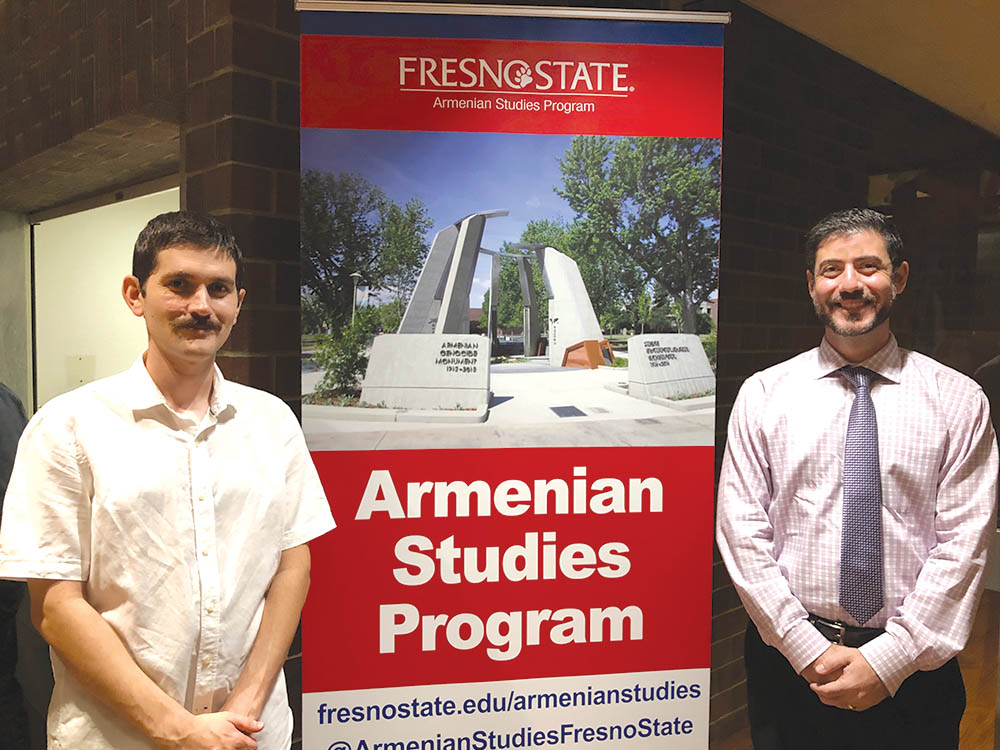
Photo: Andrew Hagopian
Arshak Abelyan
Staff Writer
“I am a Muslim by faith, and an Armenian by lineage, by blood. Genetically, I am Armenian, and that’s unchangeable. Just as I took my “Y” chromosome from my father, I took my Armenian identity from him. But I was born a Muslim,” stated Yusuf, a Muslim Armenian, who Dr. Hrag Papazian narrated in his own comic.
Dr. Hrag Papazian, the 19th Kazan Visiting Professor in Armenian Studies, presented a lecture entitled, “Muslim and Alevi Armenians,” on Friday, October 7. This was the second in a three-part series of lecture under the general topic of “Armenians and ‘Other Armenians’ in Con-temporary Turkey.”
In his presentation, Dr. Papazian discussed the developments that led to the “coming out” of some individuals within the past few decades and examined these people’s understandings of Armenianness, their experiences in the post-genocidal context, and their relations with the Christian Armenians of Turkey.
One of the biggest challenges to the Armenians, and individuals such as Yusuf, who live in the Republic of Turkey, is their own identification of who they are and how they identify. Dr. Papazian stated that the Armenian population in the modern Republic of Turkey is composed of three distinct groups: the officially recognized Christian Armenians who are Turkish citizens, the immigrants from the Republic of Armenia who are not Turkish citizens, and the Muslim-Armenian Turkish citizens or Alevi Armenians who Dr. Papazian considers as another distinct sub-group of Muslim-Armenian Turkish citizens.
For many decades, even after the Armenian Genocide, whereas some were completely unaware that they had a connection to Armenianness through lineage, many Muslim-Armenian Turkish citizens lived knowing that they had Armenian roots but usually preferred not to speak about that reality, at least publicly. Things changed, however, during the last few decades, when descendants of Islamized Armenians start-ed to publicly emerge as “Muslim Armenians” or “Alevi Armenians.”
Their perception of Armenianness, however, seems to be slightly different than that of many Christian Armenians in Istanbul (and perhaps elsewhere), and that is where a divide occurs.
Dr. Papazian shared a story where he met with a man whose name is Asadour in a courtyard of an Armenian Church in Istanbul. Dr. Papazian shared that Asadour was raised as a Muslim, but had revealed to him that he was an Armenian.
“He was extremely careful not to be overheard,” stated Dr. Papazian. “He spoke to me in an extremely low voice to the extent of causing difficulties for me when it came to transcribing my interview. However, the one and only ‘controversial’ and ‘dangerous’ theme was simply his being of Armenian descent.” Asadour described his Armenian identity to be “inescapable” after his experiences of race-based discrimination that eventually led him to understand that he would never become a Turk because he was identified by the government as well as fellow Muslims as an Armenian. Eventually, in his later years he adopted the name Asadour and became committed to learning more of his Armenian roots.
In the case of most Christian Armenians, they perceived the Armenian identity to belong to those who possessed the Christian faith and saw Muslim Armenians as not being Armenian.
There was a lack of trust coming from the Christian Armenians towards the Muslim Armenians because they questioned the possibility of being simultaneously Muslim and Armenian.
Dr. Papazian quoted an individual who had sent him an email describing his experience with the following message, “Turks think I am a Circassian, while Circassians do not accept me as one of their own. What can one do when no single race treats him as a member? He either returns to his origins, like a bird that has lost its flock, or remains permanently in between and becomes miserable like us.”
All members of the minority will always face judgement from the agents of society. In the case for Armenians and for those questioning their own Armenian identity, Dr. Papazian would add the following: to be an Armenian is to hold one’s self-identification of what it means to be an Armenian even in the face of an alternative.
 Hye Sharzhoom Armenian Action
Hye Sharzhoom Armenian Action